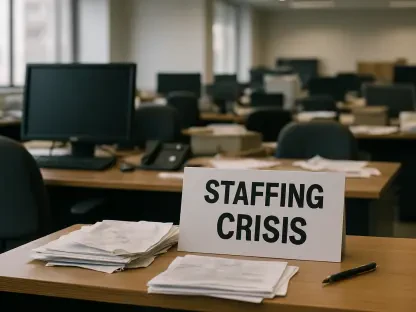Sofia Khaira is a renowned specialist in diversity, equity, and inclusion, working tirelessly to help businesses improve their talent management and development practices. As an HR expert, she has successfully driven initiatives to create inclusive and equitable working environments. Today, we delve into the gradual changes and future prospects of immigration enforcement against employers since President Trump’s inauguration, exploring the impacts on businesses and the necessary preparations HR departments need to undertake.
Can you explain the gradual changes in immigration enforcement against employers since President Trump’s inauguration?
Since President Trump took office, immigration enforcement against employers has seen a slow and steady ramp-up. Initial promises indicated swift and large-scale actions, but in reality, it’s been a more gradual increase. U.S. Immigration and Customs Enforcement (ICE) has primarily focused on smaller entities initially, likely due to resource constraints and the need to build capacity for larger enforcement actions.
Why do employer-side immigration lawyers believe there is a need for caution despite the slow pace of immigration enforcement?
Employer-side immigration lawyers advocate for caution because enforcement, although gradual, has a clear trajectory of escalation. The slow pace doesn’t negate the seriousness of the enforcement efforts but rather indicates a calculated build-up. Lawyers expect this trend to continue and potentially accelerate, which necessitates that employers remain vigilant and compliant to avoid sudden and severe repercussions.
What were the initial promises related to large-scale worksite enforcement by the incoming Trump administration officials?
Incoming Trump administration officials initially promised a robust crackdown on unauthorized employment. They emphasized large-scale worksite enforcement, suggesting a dramatic increase in raids and audits to identify and penalize employers who hire unauthorized workers. These promises created an atmosphere of heightened alertness among employers, particularly in industries reliant on large workforces.
Can you provide examples of small entities targeted by U.S. Immigration and Customs Enforcement (ICE) for raids?
Yes, ICE has targeted several small entities as part of their enforcement strategy. Notable examples include a construction site in Louisiana and a market in Philadelphia. These cases signify that no operation, regardless of size, is immune from scrutiny and potential action by ICE, reinforcing the need for all employers to adhere strictly to compliance regulations.
How might HR departments need to prepare for an increase in Form I-9 audits?
HR departments should anticipate an increase in Form I-9 audits by implementing stringent compliance measures. This includes regular internal audits of Form I-9 documentation, ensuring all forms are correctly completed and up-to-date, and providing training for staff on proper verification processes. Additionally, enrolling in programs like E-Verify can demonstrate a commitment to compliance and help mitigate risks.
What is the purpose of Form I-9, and why is it important for employers?
Form I-9 is used to verify an employee’s eligibility to work in the United States. Employers must ensure that this form is accurately completed for every individual they hire. It is crucial because incomplete or incorrect forms can lead to significant penalties for the employer, including fines and potential legal action.
Have Form I-9 audits increased since Trump’s inauguration, and is this trend expected to continue?
Yes, Form I-9 audits have increased since Trump’s inauguration. This trend is expected to continue as ICE expands its capacity for enforcement actions. The increased audits are part of a broader strategy to ensure employer compliance with immigration laws and to deter the hiring of unauthorized workers.
How do ICE agents determine their quotas for serving notices of Form I-9 inspection?
While ICE officially states that it does not assign quotas to its field offices, anecdotal evidence suggests that agents may have informal targets or expectations. Agents might aim to serve a certain number of notices weekly, potentially repurposing existing staff or hiring external contractors to meet these goals.
What is the role of the U.S. Department of Homeland Security in relation to ICE’s staffing increases, and why did DHS decline to comment?
The U.S. Department of Homeland Security (DHS) oversees ICE and has a role in approving and facilitating staffing increases to support enforcement efforts. DHS likely declined to comment due to the sensitive and strategic nature of law enforcement operations, which involve considerations of public safety and resource allocation.
How did the administration’s earlier lack of funding contribute to the gradual ramp-up of worksite enforcement?
The earlier lack of funding restrained ICE’s ability to initiate widespread enforcement actions. This limitation caused a slower-than-promised increase in operations as the agency first needed to secure adequate resources. Recent budget resolutions have addressed these shortfalls, providing ICE with nearly $10 billion to enhance its enforcement capabilities.
How does ICE’s funding improve under recent budget resolutions?
Recent budget resolutions have granted ICE close to $10 billion, significantly boosting its resources. This increase in funding allows ICE to hire more agents, conduct thorough audits, and pursue larger enforcement actions, aligning with the administration’s agenda of rigorous immigration compliance.
What is the IMAGE program, and how might ICE agents use it to meet quotas for inspection notices?
The IMAGE program is a voluntary partnership between the federal government and private sector employers to enhance the workforce’s immigration compliance. ICE agents may use this program by encouraging employers to participate, which may count towards their enforcement metrics, thus aiding in meeting unofficial quotas for inspection notices.
How does ICE determine which businesses to target for inspections and potential enforcement actions?
ICE targets businesses for inspections based on various factors, including tips from disgruntled employees, community reputations, and past records of noncompliance. Industries with high instances of unauthorized employment, such as construction, hospitality, and restaurants, are often scrutinized more intensely.
Why are employers in specific industries like restaurant, construction, and hospitality particularly concerned about the Trump administration’s enforcement efforts?
These industries are concerned due to their historically higher reliance on immigrant labor, some of whom may lack work authorization. The stringent enforcement efforts pose a significant risk of disruptions, fines, and criminal charges, compelling these sectors to be especially vigilant and compliant.
How do ICE agents confront workers during inspections, and what happens if workers cannot produce documentation?
ICE agents typically confront workers on-site, asking them to produce documentation proving their work eligibility. If an employee fails to provide the necessary documents, they are often detained for further investigation. This can lead to disruptions in business operations and fear among the workforce.
What role do disgruntled former employees play in ICE’s identification of potential violations?
Disgruntled former employees can be a substantial source of intelligence for ICE, often providing insider information about potential noncompliance. These tips can guide ICE agents to businesses that might be violating immigration laws, making such businesses “easy pickings” for enforcement actions.
Besides ICE, which other agencies are involved in evaluating employer compliance with immigration law?
Other than ICE, agencies like the U.S. Citizenship and Immigration Services (USCIS) and U.S. Customs and Border Patrol (CBP) play roles in evaluating employer compliance. USCIS conducts compliance reviews of visa petitions, while CBP might scrutinize the movement of international travelers and workers.
Why are employers concerned about international travel, and how is U.S. Customs and Border Patrol involved?
Employers are concerned about international travel because heightened scrutiny at ports of entry can lead to detentions, questioning, and inspections of electronic devices for employees. This scrutiny, overseen by U.S. Customs and Border Patrol, might affect international business activities and raise privacy concerns.
What are the potential penalties for Form I-9 paperwork violations?
Penalties for Form I-9 paperwork violations can be substantial, with civil fines reaching up to $2,861 per infraction. These fines underscore the importance of maintaining accurate and compliant documentation to avoid significant financial repercussions.
How severe can the penalties get for employers found to have engaged in knowingly hiring unauthorized noncitizens?
Penalties for knowingly hiring unauthorized noncitizens are severe. For first-time offenses, fines can reach $5,724 per violation, escalating with repeated offenses. Employers may also face criminal penalties, including imprisonment, for patterns of continued hiring of unauthorized workers.
How might employers face criminal exposure related to immigration enforcement actions?
Employers could be exposed to criminal charges if found to have knowingly hired unauthorized workers, engaged in fraudulent activities, or violated immigration-related laws. Such exposure includes potential prison sentences and underscores the critical nature of compliance.
Why are authorities focusing on employers’ use of electronic Form I-9 systems?
Authorities focus on electronic Form I-9 systems because these systems must comply with specific regulations. Noncompliance, whether intentional or not, can result in significant fines. The scrutiny ensures that employers adhere to proper documentation and verification protocols.
How should employers prepare to produce audit trails and demonstrate their electronic I-9 programs during an ICE audit?
Employers should ensure their electronic systems capture complete and accurate audit trails showing all actions taken related to I-9 documentation. Regular internal audits and the ability to demonstrate system processes in real-time during an inspection are crucial for proving compliance.
What challenges do employers face regarding the enforcement of electronic Form I-9 regulations?
Enforcing electronic Form I-9 regulations presents challenges such as understanding regulatory requirements, ensuring systems capture necessary data, and preparing for audits. Variations in system quality and compliance further complicate adherence to these regulations.
How does the quality of electronic I-9 systems vary, and what issues might non-compliant systems present?
The quality of electronic I-9 systems can vary significantly. Non-compliant systems may fail to capture required data accurately or lack robust audit trails, potentially resulting in substantial fines. Employers must select reliable systems that meet all regulatory standards to avoid these issues.
What is your forecast for immigration enforcement under future administrations?
Future administrations might continue to intensify immigration enforcement, particularly focusing on employment compliance. Employers should anticipate ongoing scrutiny and prepare by maintaining rigorous documentation and compliance practices. The focus on electronic systems and data integrity is likely to persist, emphasizing the need for robust, compliant I-9 processes across all industries.









